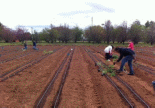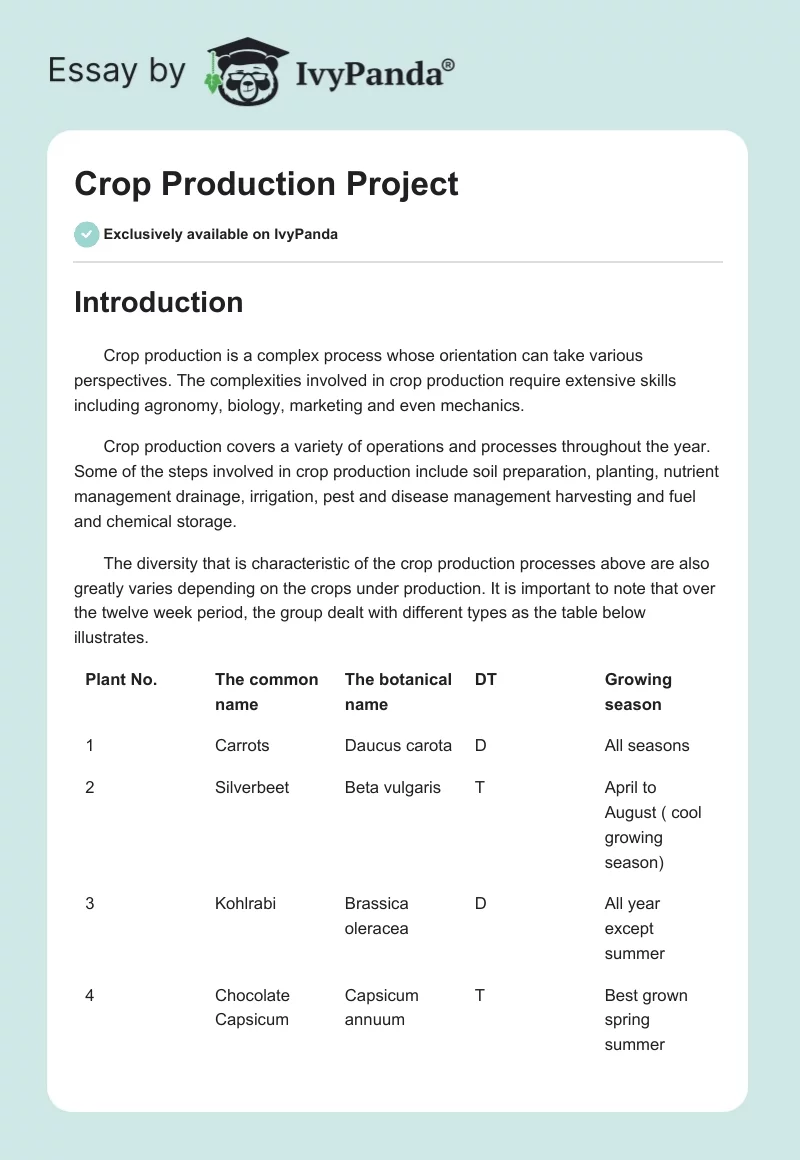Introduction
Crop production is a complex process whose orientation can take various perspectives. The complexities involved in crop production require extensive skills including agronomy, biology, marketing and even mechanics.
Crop production covers a variety of operations and processes throughout the year. Some of the steps involved in crop production include soil preparation, planting, nutrient management drainage, irrigation, pest and disease management harvesting and fuel and chemical storage.
The diversity that is characteristic of the crop production processes above are also greatly varies depending on the crops under production. It is important to note that over the twelve week period, the group dealt with different types as the table below illustrates.
Table 1: Different types of crops under study
In this report however, there will be a brief literature review on the production background of carrots and silverbeet. The two represent the two wider groups to which every crop under study belongs.
Brief literature Review
Plant Name & Variety of carrot and Silverbeet
According to Rose (2009), carrots are vegetables by virtue of their horn shape and root nature. Most carrot varieties come in different colors like red, white, and yellow with orange being the most common. A fresh carrot has a crisp texture. The carrot tap-root is mostly taken because of its high concentration of vitamins.
Like carrots, Silverbeet has a range of colors and leaf textures. Its stem colors and plant sizes also differ among the varieties, which include Success, Fordhook Master, Fordhook giant, and Compacta Slo Bolt which are all dark green. These varieties have different growing seasons, height, and leaf colors (Wade, 2006).
Botanical names of Carrot and Silverbeet
Carrot’s generic name is Daucus and specific name is carota. Its scientific name is therefore Daucus carota subsp. sativus (Rose, 2009). Silverbeet, at times called Swiss chard, is known scientifically as Beta vulgaris. It falls under the L. Cicla group (Wade, 2006).
Initially, carrots were never grown for consumption of their roots but were grown for their aromatic leaves and seeds. This tradition dates back to the 1st century. Europeans started growing carrots between the 8th and the 10th century.
Silverbeet is mainly grown as a leaf vegetable. It bears a lot of semblance with spinach. However, it has large, coarse, and mild tasting leaves. Unlike spinach, it can tolerate cold, heat, drought, and disease.
Nevertheless, Silverbeet and spinach belong to the Chenopodiaceae family where majority of root vegetable beetroot belongs. Originally grown in Portugal, Spain, and the Mediterranean islands, silverbeet has today spread to Britain, Australia, and New Zealand, among other countries (Wade, 2006).
Carrot is grown because of its nutritional value to humans. It has beta-carotene that is normally metabolized into Vitamin A that helps in maintaining good vision. Apart from that, it also has dietary fiber, antioxidants, and minerals (Rose, 2009).
Silverbeet is good for human consumption because it is low in saturated fat and cholesterol. It has high dietary fiber and contains vitamins A, C, E, and K. It is also rich in calcium, iron, magnesium, and phosphorus. These nutrients make it ideal for weight loss and maintenance of optimum health (Wade, 2006).
Growing season for Silverbeet keeps changing depending on the varieties. For instance, Compacta Slo Bolt is grown between the 10th and 14th weeks of the year while Fordhook giant, Fordhook master, and Success are grown between the 9th and 10th weeks (Wade, 2006). Carrot do well in seasons with full sun when they grow best (Rose 2009).
Silverbeet can grow in wide range of climatic conditions including sub-tropical, temperate, and cold temperature climates (Wade 2006). However, it grows best in coastal regions. Carrot grows best in regions with shady areas with full sun (Rose 2009).
A series of bacterial, viral, fungal, nematodes and parasitic infections affect carrots. These include bacterial leaf blight, alternaria leaf blight, cyst nematodes, and alfalfa mosaic (Rose, 2009). Pest and diseases that affect Silverbeet include cercospora leaf spot and beet webworm moth (Wade, 2006).
It is advisable to use gloves when harvesting Silverbeet to curtail cuts and abrasions that may increase the chances of a disease being transferred from one plant to the other mechanically. There is a need to take preventive measures to ensure carrots don’t contract diseases.
The Report
The procedure
During the entire twelve week period, students participated in different ways. Farm trips, lectures, tours to facilities and agricultural fields were some of the ways through which students gave their input in the study of crop production.
A detailed description of the activities that the students engaged in will form this section of the report. Again, it is important to note that the description will not necessarily give precedence of the dates the activities took place; rather, it will subtly apply the generally accepted procedure in crop production.
A tour to the firm and fields of agriculture exposed the students to the nursery practices that are crucial in crop production. In during this time, students learnt about seed and seedling/plant choosing. More importantly, the students chose the seeds and seedlings depending on the seasons they were likely to do best.

Due to constraints, each student chose one seed and one seedling. Students learnt more about potting up, planting seeds in a nursery as well as the available alternative vegetables and fruits including tomatoes, cut flowers and strawberries. During the selection sliverbeet was the most common seedling allocated. Allocation to the students of the horticultural field portions for planting took place during the day of seedling allocation.

Besides planting seeds, tomatoes and strawberry transplantation of seedlings took place. The above two were however not transplanted to the field rather in the glasshouses where the conditions such as temperature were within a temperature range of 210 C and 280 C favorable for their growth and development.
A one hour lecture covering micro-propagation especially on orchid pollination, propagation and tissue culture followed the planting activities. Further, through a lab session, students were better able to identify with precision both the male and female types of the orchid.

During the following trip to the firm a lecture and demonstration of orchard pruning took place. The session was informative concerning importance of pruning in canopy management to ensure optimal fruit production in the case of orchards. Additionally, the students leant that pruning also involves stem and/or cane management of the plants involved.
In a bid to gain a different view on crop production students visited a mushroom farm during a field trip to Bilpin Orchard and Mushroom farm. The students also tackled the four basic components of composit mushroom production.

A two-hour lecture on postharvest activities followed the visit to the mushroom far. In the lecture, students learnt about fruit development prevention of postharvest loses and the benefits of fruit taking.
During a field visit to UWS weather station and field visit (local farm) the students learnt more about orchards in Pine Crest orchard. Specifically, the farmer explained in detail about grafting besides stressing on the dangers posed by weeds and fungi infections.
Result
Most of the crops under study went through the crop production process successfully. However, the tomatoes suffered several set- backs throughout the semester with them being moved on 2 occasions between different environments.
Additionally, most crops could not be harvested due to various reasons including over irrigation and/or excessive rain. Furthermore, there was students experienced difficulty in controlling weeds especially due to failure to spray herbicides indiscriminately
Discussion
As disclosed above, most of the crops did not do well. It is clear that some essential parts of the crop production cycle were missing. Specifically, there was consistent failure on the part of student to study the weather patterns thus affecting the irrigation patterns.
Besides, application of herbicides did not take place in an appropriate way. Considering the above, it is therefore necessary to ensure a better understanding of the weather patterns to avoid over and under irrigation in future.
References
Rose, F. 2006. The Wild Flower Key. London: Fredrick Warne.
Wade, S. 2009. Silver beet growing: Prime Facts. Web.


